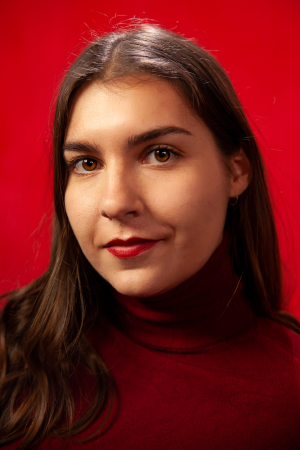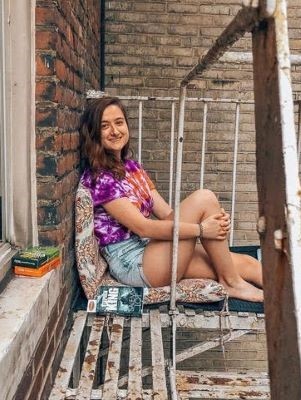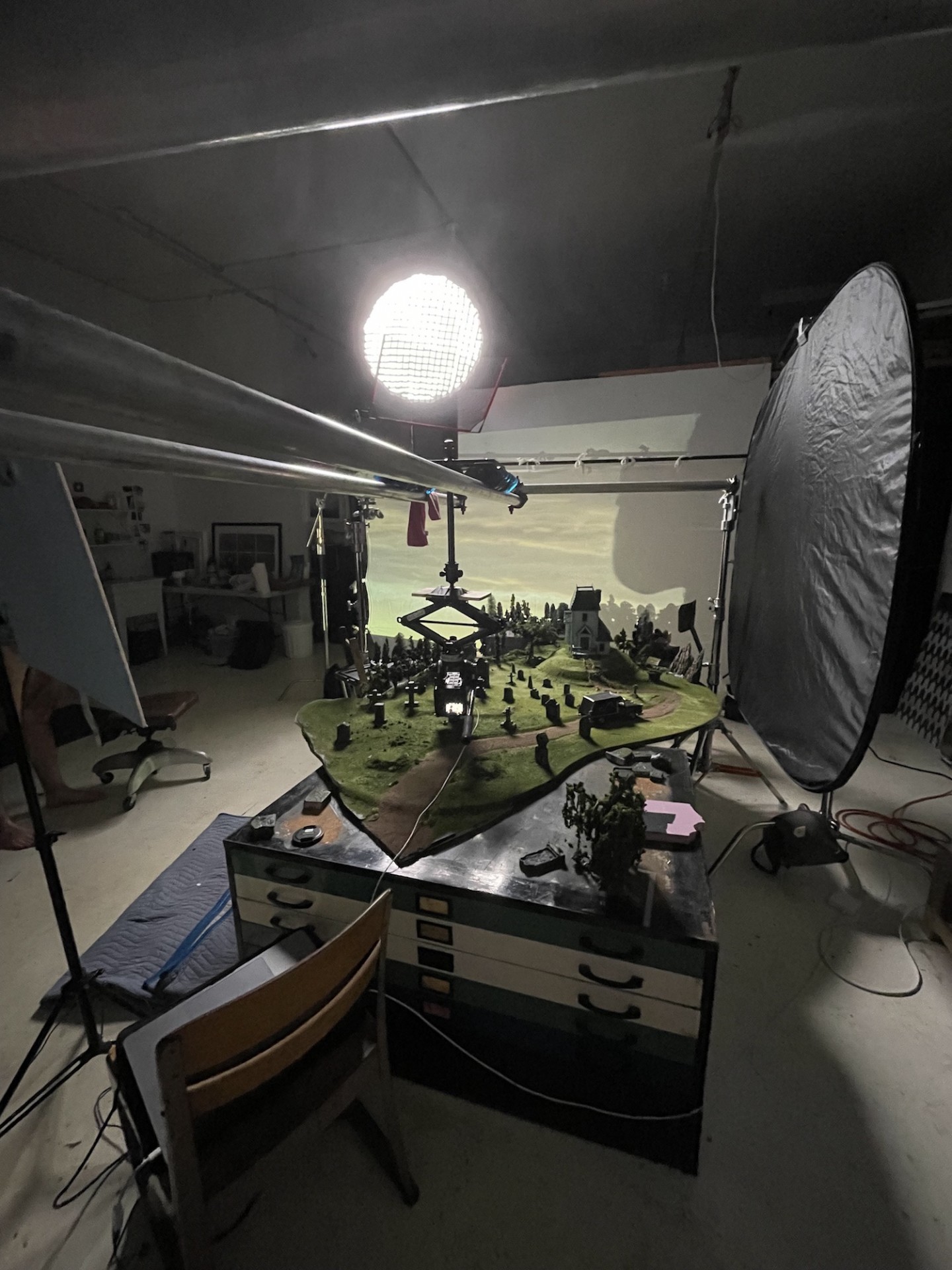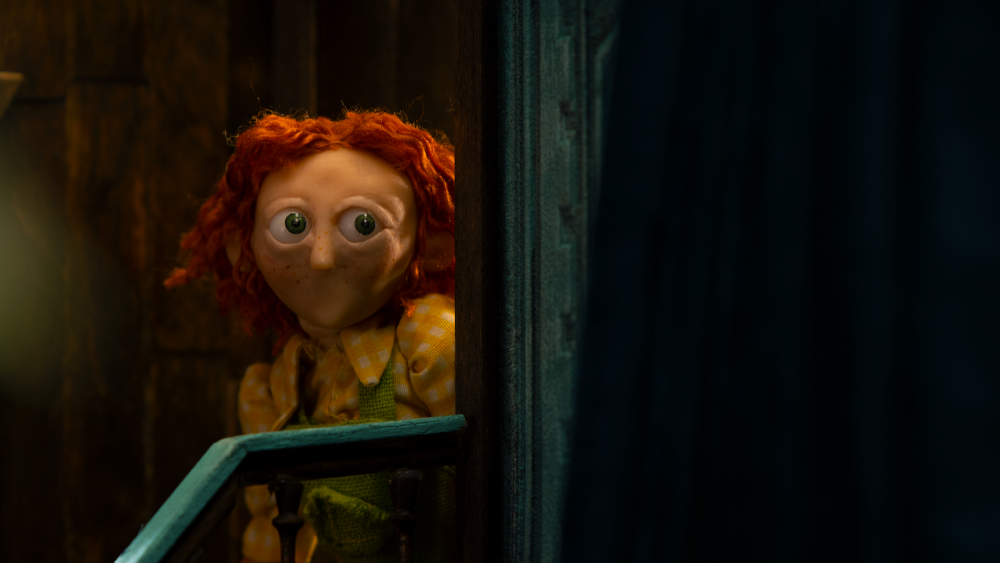Animation Conversations: The All-Female Team Behind Columbia's First Stop-Motion Animation, 'The Undertaker's Daughter'

Animation Conversations is an interview series with Film faculty, students, and alumni where we discuss working as screenwriters, directors, and producers in the animation industry.



This week, we sat down with the all-female team behind The Undertaker’s Daughter, the Second Year Film by Directing student Paula Bourgie, and the first stop-motion animation project produced at Columbia. Creative Producing students Stephanie Choriatis and Kinder Labatt also joined us to talk about their experience producing this special and unique project together.
Paula, what led you to exploring stop-motion animation as a director?
Paula Bourgie [PB]: I discovered animation as a teenager. There was a contest to make a Lego stop-motion movie, and I decided to try it. The only Legos I had were Harry Potter Legos, and I ended up re-doing Harry Potter and the Prisoner of Azkaban in its entirety in a Lego stop-motion format. I learned so much about filmmaking and animation from that experience, and I’ve always loved it since. Then in undergraduate school, I was part of a formal project where we created an adventure, Indiana Jones-type of stop-motion project. I came to Columbia straight after undergrad, and it just seemed like a perfect moment to make an animated project when the pandemic happened. I was trying to find something that didn’t require big crews or a big cast, and I didn’t know if I would produce my project here in the US or in Canada, so it seemed like a simple project. Obviously, a stop-motion project is not simple in any way, but COVID safety-wise, it was really practical. That was my journey to making The Undertaker’s Daughter.
Where did the idea for The Undertaker’s Daughter come from?
PB: The Undertaker’s Daughter is about an undertaker who has visions of death and his daughter, who is not interested at all in the business. She likes the living and gardening, and anything that is alive. She has a vision of her dad dying, and the story follows how she deals with that.
My family ran a funeral home for a century. The year I was born, my dad sold the business, so I never became involved, but it’s something I grew up hearing about, and it’s such a fascinating, underrepresented world. My dad, who is not superstitious or religious in any way, had these moments in his life where he sensed that people were going to die. I always thought that was such a fascinating idea—an undertaker who could sense death. I decided to write something about that, and thought the fairytale format would lend itself well to the narrative. And what better way to tell this story than in animation? It was too big-scale to produce in a live-action format, and animation really gave me the ability to fully realize the vision I had in mind.
Kinder and Stephanie, how did you become involved in the project?
Kinder Labatt [KL]: I was just obsessed with Paula [Laughter], so I kept asking her what she was going to do [for her Second Year Film]. She sent me the logline for The Undertaker’s Daughter, and I thought it was amazing. I loved the idea. I’m also Canadian, so [Paula] knew I could go to Canada to help with the production of it, which was a plus. Once I read the script, I was just so excited. Stephanie and I had worked together a lot too. We were both looking for a COVID-safe project, but also still wanted to be ambitious.
Stephanie Choriatis [SC]: One day, I texted Kinder and told her we should find someone who wants to make a stop-motion and we could produce it. She told me that Paula was making a stop-motion and she was going to help produce it. It was a pretty magical moment.
Did either of you have any experience working with animation before collaborating with Paula on this project?
SC: I went to school in Grand Rapids, Michigan for film and video, and after I graduated, I moved to New York and started teaching at an elementary middle school. The first curriculum I taught was a stop-motion animation class. I hadn’t been an animator before this. I really wanted to be a teacher, and I loved animation and had done some practice with it, but by no means considered myself an animator. But it was something really tactile for the kids that could help them grasp basic principles of cinema, like how to create a simple story. I fell in love with stop-motion animation by teaching it, and then throughout the last several years, I’ve done big and small projects with different groups of students.
KL: I had experimented with claymation in high school, and all of my favorite films were claymation growing up. That especially drew me to this project. I had never produced a stop-motion, either, and it’s the first stop-motion animation that Columbia has done. It was a long process of two months of us working with the school to see if the project would be approved. We convinced them, and it was so worth it.
What was the pre-production process like compared to other live-action shorts you’ve either produced or directed?
PB: It’s so much more pre-production. When you’re shooting, it takes such a long time to animate and build a scene that you can’t over-shoot at all. I had to create an animatic of the entire movie and edit it before we shot it. We also recorded the voice-over performances beforehand and made an entire soundtrack of the film so that we knew exactly what to shoot. That way, we wouldn’t waste any time once we got to set.
Another huge part of it was building the sets. We build every single thing—the puppets, the sets, the props, the costumes. Because every single thing you see on camera has been hand-built, it does take a really long time. Logistically, it was a real challenge, and it was bigger than any pre-production that I had done.
KL: We calculated it, and it took 400 man-hours just to build the set and the puppets alone. And that’s not even counting any of the animatic or test shoots. Paula built most of it, and I came [to Canada] two weeks before we shot to help finish the building. Another really cool part of the pre-production process was casting for the project.
SC: The casting was so fun. Because we were remote, we opened up our casting call to anyone in the world. We ended up working with a woman in London and a man in Tennessee. Because we were doing remote recording, there was tech-prep needed for that, but we were also able to secure these actors who would not have typically been available if we had to do in-person recording. Producing remote voice-over was something that I had done previously, but I hadn’t done it in a creative sense. It was always in a nonfiction context. It was so cool to watch Paula direct these actors through Zoom, but knowing that their faces wouldn’t appear [in the short]. At some points, I would close my eyes, and I would think, “I’m listening to a Disney movie, or I’m listening to a Tim Burton film right now.”

KL: What Paula did, which I thought was brilliant, was before we even recorded, she played a soundscape she had made which really set the tone. We all felt like we were in the same room together, in the same space, in this little world she had created.
Paula, how did directing for voice-over performance compare to directing for live-action?
PB: I think it’s a similar process in that you have to understand the character, and you have to make sure the actor understands the character. Sometimes when you’re on set, you feel the pressure of so many other things—people are waiting, there’s a timeline. But we recorded [the voice-over performances] before production on The Undertaker’s Daughter, so I had more time to work with the actors.
What was the production period like?
KL: It was thirteen days. It went by fast and slow at the same time. It was exhausting in an amazing way. It was amazing seeing all the work Paula was doing animating, and how fast she got.
PB: We were only four people on set: there was me, Kinder, my director of photography, and our COVID Compliance Officer. Once the animation part started, it was slow in the sense that in three hours, you capture a small movement. It seems like you’re doing nothing, but then at the end of the day, you look back and see, “I’ve done all of this.”
It was intense physically as well. I was standing over the set, trying to move these characters and trying to avoid touching the rest of the set. I had to crouch every time we took a photo, otherwise I would block the light. We joked that I had done 400 squats a day. Yeah, production was so intense, and we learned so much about animating while we were animating. What I realized was that the better animator you become, the slower you get, because you spend more time being very precise and specific about how this character moves. You can see that in the film actually. The earlier scenes that we shot are choppier, but by the end, I got a smoother and more organic movement. But that also meant I was spending more time on every frame.

What were some of the creative challenges you encountered?
PB: There are so many logistical challenges, like how do you make a character walk? You can’t balance them, so they have to either be screwed into the set, or maybe they have a rig that’s attached to their backs. And sometimes a movement doesn’t work. You start doing it, you get two hours in, but when you play it back, you see that it’s not working. Then you have to start over again. I learned so much on this project.
KL: At one point on set, we were trying to figure out how to make the camera move up and down. We had a dolly, so we could make the camera move forward and backwards. But for the up and down movement to work, the camera would have to move with such precision. It would have to go up a millimeter at a time, and also be consistent every time. We were trying to figure out how to do that, and our director of photography’s father suggested that we use a car jack. So we drilled the camera into the car jack, and it worked. Later on, we were watching the behind-the-scenes of Coraline, and they also used car jacks in their film. We were using the same kinds of techniques as they were. There was a lot of creative problem-solving like that. You wouldn’t think we’d need a car jack on an animated film, but truth be told, we needed one.
Also, because everything is so small on the set, when Paula tells me, “I need feathers,” I couldn’t just get any feathers. They have to be a very specific kind of feather for them to look right. We ended up using cat toys, because they have these small, tiny feathers.
SC: Another logistical challenge for me was that I couldn’t get into the country because of the pandemic. Creatively, it was so hard not to be able to support my teammates, but also, I was trying to think of ways I could help remotely from my computer. I’d be researching craft stores in Montreal, just trying to help remotely however I could. It was a challenge being so far, but wanting to support the project in the way I could.
What were some of the most rewarding parts of the process?
PB: For me as a director, having your vision fully realized to the last detail. When I was first thinking of the project, I did these concept art drawings. After building the sets, which took two months, it was exactly how I imagined because I had full creative control for every single detail in the film. That was amazing. It’s not something that we have the chance to experience as young filmmakers, especially with budget constraints when you’re doing live action. You’re always adapting to whatever resource you have available, but [for The Undertaker’s Daughter], we were able to fully build everything. It was incredibly rewarding.
SC: The most rewarding part to me was being able to say that we produced something that has never been produced at Columbia by students before. It’s so rare that projects like this come along, so to be part of it is just really special. Also, the fact that we are a female-led production team is really amazing. It’s a female-led story, and we all bring our experiences into this project. That alone is so inspiring.
KL: Seeing at the end of the day, all of the hard work Paula had done...it looked so beautiful. When I finally got to Canada and was able to hold these puppets in my hands that I had seen through the screen for months, I just couldn’t believe it. We had so many set-backs, whether it was the pandemic, traveling across the border, and the fact that it all came together and we all worked hard...the whole thing was amazing.
What’s next for you all?
KL: I’m shooting my thesis film in December. It’s a short film that I’m producing about Margaret E. Knight, who was a revolutionary trailblazer. She invented the paper bag machine in the 1860s, and we’re hoping that after the short we’ll be able to make it into a feature some day as well. We’ll be launching our Seed & Spark campaign in October.
SC: I am in post-production for my thesis film. It’s a documentary short featuring women who have left Christian purity culture. I’m also working on fundraising and looking towards creating a feature down the road.
PB: I’ll be working on the post-production of The Undertaker’s Daughter for a while. I’m planning on filming live action shorts for my thesis and non-thesis films, so I’m working on developing those scripts now.
Do you have a favorite animated work that’s been an important touchstone for you?
KL: The first thing that comes to mind is Chicken Run. I love it. It’s amazing. It’s everything I want in a film.
SC: Chicken Run was also one of the first stop-motion films I saw as a kid and I was so obsessed with it. I’m also just a huge fan of Disney and the heart of the stories that they make. I love them.
PB: The first one I can remember watching and loving is Tim Burton’s The Nightmare Before Christmas. That was a big one for me. Also Corpse Bride and Wallace and Gromit, which I love. Laika Studios is also so great. They blend digital animation with stop-motion animation to create these works that we’ve never seen before. For example, Coraline was a big source of inspiration for tone and aesthetic for this project.

Paula Bourgie is a director from Montreal Canada, based in New York City. She is currently pursuing an MFA in Film at Columbia University. Since discovering stop-motion at the age of ten, she has sought animation projects of all kinds and gained experience in stop-frame, hand-drawn, and 2D digital animation. Through ambitious narrative student projects, corporate work, web series branding, and miniature building, BourgiePaula has honed her skills as a director, animator, and art director. The Undertaker’s Daughter is the logical next step in her journey, combining the crafts she’s developed in the past fifteen years.
Stephanie Choriatis is an award-winning independent film producer of narrative and non-fiction films based in New York City. She works as an educator for hands-on filmmaking and digital media education with students of all ages, from elementary school to college. She is attending Columbia University’s MFA program in Film, with a concentration in Creative Producing and is a recipient of the Hobson/Lucas Family Foundation Fellowship. Stephanie has created a stop-motion animation curriculum for elementary and middle school students, teaching them the principles of animation. She encourages the kids to change the way they view the world by bringing objects to life with animation. Additionally, Stephanie worked as a video producer at Manhattan Prep, and produced dozens of education animated videos for varying educational content. Her main goal is to use media to educate and empower others to create impactful media themselves.
Kinder Labatt is a Canadian producer, writer, and filmmaker based in New York City. She is currently completing her MFA in producing at Columbia University. An avid fan of satire and comedy, Labatt often incorporates topics relating to gender and politics into her work. Her first short film, Free Pot, was featured in the 2018 Crown Heights Film Festival at the FiveMyles Gallery in Brooklyn, NY. Her original pilot script, Reality, received the inaugural Charles J. Brucia Award at NYU’s Tisch School of the Arts. Her recent works include Bake Sale, a short satirizing PTA mothers, Madame Defender, a pilot script that explores a fictional account of the world’s first female dictator, and The Undertaker’s Daughter, a short stop-motion animated short currently in post-production. When taking a break from developing stories about strong, powerful female characters, Labattshe is probably singing a Janis Joplin song out of tune or baking bread, or more likely, both.